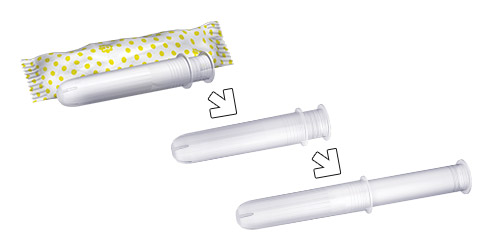Choosing the right tampon absorbency
When choosing the level of absorbency of a tampon, you need to consider several factors, including menstrual flow, risk of leaks and toxic shock syndrome. Let’s learn more about your options.

Tampons
The first tampon was marketed nearly a century ago, some forty years after sanitary pads. Since then, manufacturers have continued to improve their products in response to women’s specific needs.
As they absorb menstrual blood, some tampons expand width-wise to fit the contours of a woman’s body and provide more comfort and better protection. Others simply expand lengthwise. Available in several absorbencies and with or without an applicator, tampons are getting smaller, yet more effective! Features to choose from include a protective veil to facilitate removal and keep fibre particles away from the body, central channels for faster absorption and compact packaging for more discretion.

It is normal for some young girls and women to be nervous the first time they insert a tampon. But tampons are easy to master and provide extremely convenient feminine protection, especially for those with an active lifestyle.
Absorbency levels
To adapt to all menstrual flows, tampons come in various absorbency levels: light, regular, super and super plus. Tampons with light absorbency are more slender, making them a perfect fit for young women. Since menstrual flow changes during a cycle, being able to use different absorbencies can be very helpful. For example, at the start of your period, you can use light, followed by regular when menstrual flow is more abundant, or, if you have a heavy or extra heavy flow, super and super plus.
Tampons with light absorbency are more slender, making them a perfect fit for young women. Since menstrual flow changes during a cycle, being able to use different absorbencies can be very helpful. For example, at the start of your period, you can use light, followed by regular when menstrual flow is more abundant, or, if you have a heavy or extra heavy flow, super and super plus.
The 8-hour rule
Tampons should be changed every 4 to 8 hours, or more frequently in the case of heavy flow, to prevent vaginal infections and avoid the risk of developing toxic shock syndrom (TSS).
 Women are strongly discouraged from wearing tampons for more than 8 hours. Consequently, it is best not to use tampons overnight.
Women are strongly discouraged from wearing tampons for more than 8 hours. Consequently, it is best not to use tampons overnight.
Toxic shock syndrome
Tampon use is one of the causes associated with TSS. It is a serious, potentially life-threatening infection resulting from the accumulation in the body of toxins produced by certain bacteria.
The risk of developing TSS due to tampon use is, however, minimal. It is estimated at 1 to 17 cases in 100,000 menstruating women and girls. The incidence of TSS appears to be higher in women under the age of 30 and in adolescent girls.
To reduce your risk of TSS:
- Choose the lowest absorbency for your menstrual flow to make sure you do not keep the tampon in longer than necessary.
- Wash your hands with soap before inserting or removing a tampon.
- Change your tampon at least every 4 to 8 hours.
- Alternate between tampons and pads.
The signs and symptoms of TSS are as follows:
- Fever
- Nausea and vomiting
- Diarrhea
- Headaches
- Body aches and pains
- Dizziness
- Feeling faint
- Confusion
- Sunburn-like rash, especially on the palms of your hands and soles of your feet
- Low blood pressure
- Weak, fast pulse
While TSS is rare, if you experience any of these symptoms while wearing a tampon, remove it and consult a doctor as soon as possible.
Pharmacy services
To discover the full lineup of feminine protection products available at Uniprix, drop by your local store. If you have questions about menstruation, premenstrual syndrome (PMS), toxic shock syndrome, contraception or pregnancy, speak with one of your family pharmacists.
The pharmacy services presented in this section are offered by pharmacist owners who are affiliated with Uniprix. The pharmacists are solely responsible for the professional activities carried out during the practice of pharmacy. These services are offered in participating pharmacies only. Certain fees and conditions may apply.
* The information contained herein is provided for informational purposes only and is not intended to provide complete information on the subject matter or to replace the advice of a health professional. This information does not constitute medical consultation, diagnosis or opinion and should not be interpreted as such. Please consult your health care provider if you have any questions about your health, medications or treatment.
